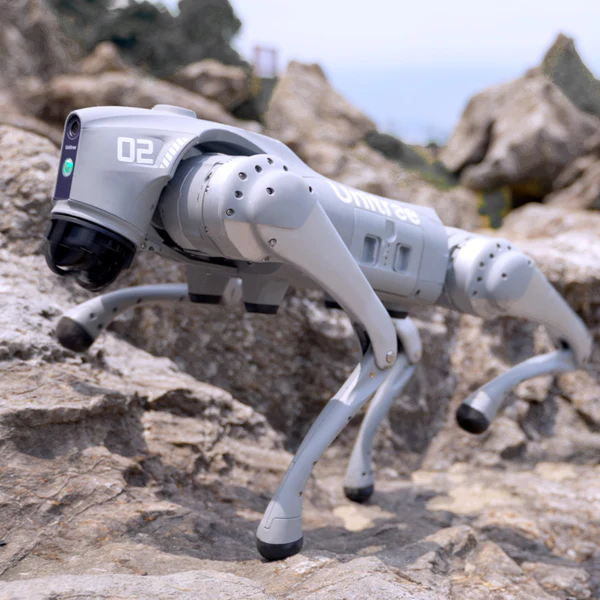
Blog Articles
Why Unitree Go2 Quadrupeds are Transforming Classrooms and Advanced Robotic Labs Worldwide
November 12, 2024 — 4 minutes
The Rise of the Unitree Go2 Quadruped Robot
In the rapidly evolving world of robotics, Unitree Go2 stands out as a prime example of how advanced engineering and intelligent design can revolutionize both education and research. As a four-legged, or “quadruped,” robot, the Unitree Go2 offers unique capabilities that make it a favorite among educators, students, and researchers across the globe. But what exactly makes this robot so special?
The Unitree Go2 combines strength, flexibility, and intelligence in a compact and user-friendly package. It offers impressive features that include high-speed locomotion, precise maneuverability, robust obstacle handling, and state-of-the-art artificial intelligence (AI) algorithms for learning and decision-making. The robot’s design is inspired by animal movements, giving it the ability to walk, trot, gallop, and even adapt its behavior in response to different terrains and environments. This flexibility allows it to perform tasks ranging from educational demonstrations and engineering projects to complex real-world applications such as search and rescue missions.
Capabilities that Make the Unitree Go2 Stand Out
1. High-Speed Locomotion and Stability
The Unitree Go2 can reach impressive speeds while maintaining stability, thanks to its efficient leg design and cutting-edge control algorithms. This makes it ideal for demonstrating real-world applications of physics and motion, helping students understand concepts like balance, force distribution, and dynamic response.
2. AI-Driven Adaptability
Equipped with an advanced AI framework, the Unitree Go2 can adapt to its surroundings, learning from experiences and improving its movements. This AI-driven adaptability is what makes it an excellent fit for research labs focused on robotics and artificial intelligence.
3. Ease of Use for Educational Institutions
The Unitree Go2 comes with user-friendly interfaces that allow students and educators to easily program and control its movements. This accessibility means students can dive into hands-on STEM learning without extensive prior knowledge of robotics, making the Go2 a favorite tool for teaching coding, engineering, and AI principles.
4. Durability and Versatility
Designed to handle different terrains and environmental conditions, the Unitree Go2 can operate indoors and outdoors, making it versatile for a wide range of applications. Researchers can test the robot’s capabilities in complex scenarios, exploring everything from basic gaits to complex maneuvers and real-world applications.
Spotlight on Research: Cutting-Edge Applications of Unitree Quadrupeds
The popularity and adaptability of the Unitree Go2 make it a prime candidate for groundbreaking research in robotics. Here are two recent research papers that leverage quadruped robots like the Unitree Go2 to push the boundaries of robotics.
1. Differentiable Simulation for Learning Locomotion
In the research titled “Learning Quadruped Locomotion Using Differentiable Simulation,” scientists explored a new way of teaching robots how to walk using a technique called differentiable simulation. Unlike traditional training methods that often require large datasets and time-consuming trial-and-error processes, this approach models real-world physics more precisely in simulations. By providing the robot with a “shortcut” to learn different gaits, it significantly reduces the time and data required to develop stable and adaptive movement patterns. For example, a quadruped robot like the Unitree Go2 can quickly learn to trot on smooth ground and transition to galloping on rough terrain by leveraging this innovative simulation process.
This method has implications beyond learning basic gaits. It enables robots to rapidly adapt their movements to changes in their environment, which is critical for real-world scenarios. Additionally, the capability to seamlessly transfer skills learned in simulation to a physical robot means that researchers and students can experiment with new behaviors quickly and see their effects in real time.
Source: https://arxiv.org/abs/2403.14864
2. Biologically Inspired Neural Circuit Priors
The research paper “Neural Circuit Architectural Priors for Quadruped Locomotion” takes inspiration from nature to improve robotic movement. The researchers designed an artificial neural network (ANN) that mimics the neural circuits found in animals’ limbs and spinal cords. This biologically-inspired model acts as a “shortcut” for robotic learning, enabling quadruped robots like the Unitree Go2 to achieve natural-looking movements faster and with less data compared to conventional methods.

This innovation means that instead of starting from scratch, the robot has “built-in knowledge” about how to move its legs, similar to how animals are born with instincts that help them walk. By incorporating these architectural priors into the AI framework, the robot can adapt to changes in its tasks or environment with greater ease. This makes it a valuable asset in both research settings and educational demonstrations, where adaptability and efficiency are key.
Source: https://ncap-quadruped.github.io/
Why Unitree Go2 is a Classroom and Lab Favorite
The integration of advanced technologies, as demonstrated by the highlighted research papers, underpins the Unitree Go2’s appeal. In classrooms, it provides students with a hands-on experience in programming, engineering, and AI. For research labs, it offers an adaptable and efficient platform for exploring the frontiers of robotics and AI.
Key Benefits Include:
- Enhanced Learning Outcomes: The hands-on experience with advanced robotics engages students and enhances their understanding of complex concepts.
- Flexible Applications: From navigating different terrains to adapting to real-world tasks, the Unitree Go2 is versatile and adaptable.
- Cutting-Edge Research Capabilities: Its robust AI and adaptive capabilities make it ideal for conducting groundbreaking research and testing new theories in robotics.
Shop More Products
From classroom-friendly kits to hands-on tools: Explore our hardware, packages, and accessories tailored for the educational journey.